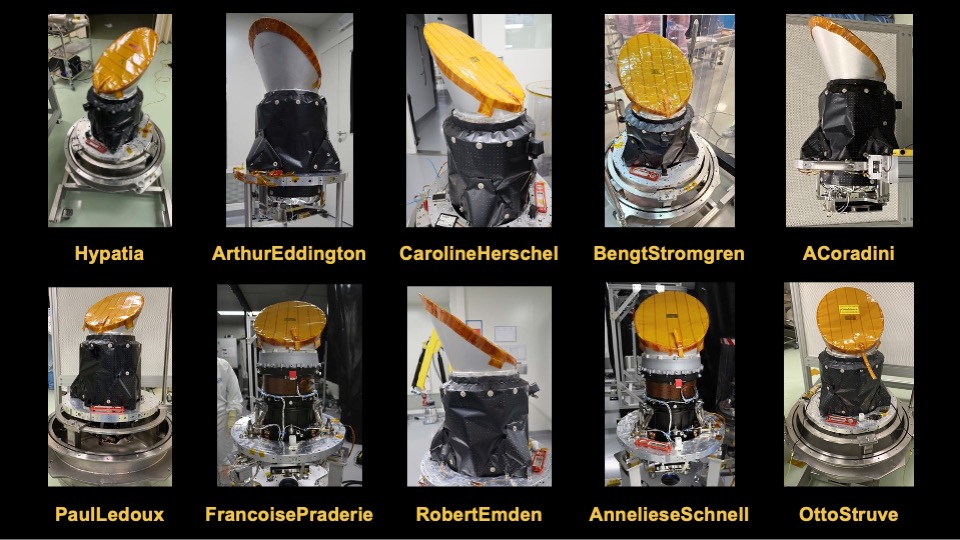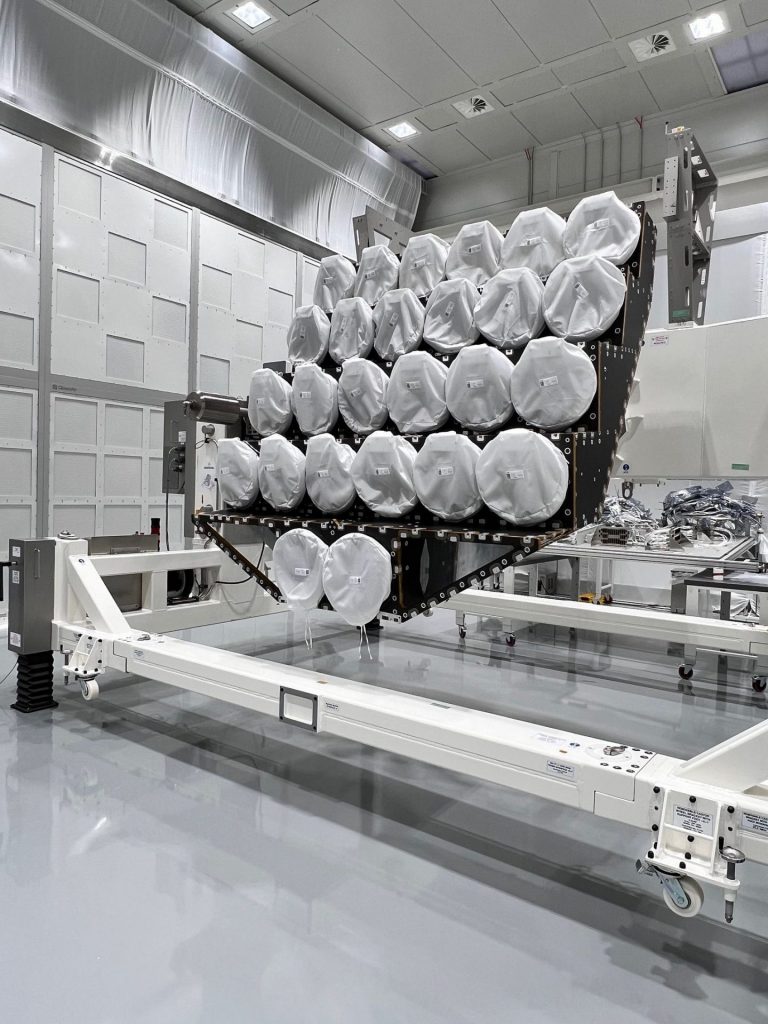How many earth-like planets orbit the habitable zone of solar-like stars? How planets form and evolve in their planetary systems? What about the interaction with their stars? These are among the questions the ESA PLATO mission is called to answer, through exquisite measurements of exoPLAnet Transits and Oscillations of stars (you now know the origin of the PLATO acronym). The “transit” measurements yield information on the size of the planets, while the “stellar oscillations” give us the mass and age of the stars, which in turn are fundamental to assess the mass and age of the hosted planets. The exquisite quality of all such measurements is secured by 26 ultra large field-of-view cameras that make the eyes of the PLATO mission.
It is the first time that a satellite devoted to the study of the Universe adopts a battery of telescopes instead of a single one. The reason for this unusual choice is driven by the science behind PLATO that calls for observations of a large number of “bright” stars for long- and continuous-time intervals (from several months to years), with precision and sensitivity that can be achieved only from space with a telescope of at least 1m in size. However, a 1m size telescope is not able to provide the large field-of-view that is necessary to observe many bright stars in a shot, as required to fulfil the science requirements, and this limit is intrinsic to optical systems; only small size telescopes can provide large fields-of-view.
Hence the idea behind PLATO design: combining a battery of telescopes to gain at the same time the needed accuracy and the large field-of-view. A single telescope of PLATO looks at a field-of-view equivalent to about 5,200 times the area covered by the full Moon. This results in a very challenging design; each telescope is a refractor of 6 lenses, each with size ranging from 12 to 18 cm in diameter, made from 5 different kind of glasses chosen to get the best optical performance, the minimum risk of aging in space, the required resilience to the mechanical and acoustic environments. Each camera is made by a telescope – completed with a baffle to secure thermal dissipation and straylight containment – a focal plane which hosts the CCD detectors and the front-end-electronics. Multi-layer insulation and a number of resistors and sensors provide the tools to thermally control the camera temperature. Two of the cameras, called “fast”, are optimised to observe very bright stars and are used also for fine guidance of the satellite. The fast cameras observe with a cadence of 2.5 s. The other 24 cameras, called “normal”, observe with a cadence of 25 s and use 4 CCD of 4510×4510 pixels each.
The normal cameras are grouped in sets of six and each set points at a direction of the sky 9 degrees from the vertical to the optical bench. In such a way, the fields observed by each set of cameras are partially overlapping and the observed total field-of-view covers an area on the sky equivalent to 10,500 times the size of the full Moon.
PLATO is the 3rd mission of Medium class in the Cosmic Vision 2015-2025 program of the European Space Agency. The PLATO satellite will be launched by means of an Ariane 6 rocket from the European spaceport in Kourou at the end of 2026 toward the Lagrangian point L2, distant 1.5 million kilometers away from the Earth. Scientists and engineers from 15 countries and ESA engineers’ have been collaborating in the design and production of the PLATO payload under the ESA umbrella and coordination. Selected by the ESA Science Program Committee in 2014 and adopted by the ESA program in 2017, the mission entered the implementation phase at full regime after the Mission and Payload Critical Milestone, successfully passed in 2021.
With a remarkable coordinated effort, research institutes and industries spread in Italy, Germany, France, Portugal, Spain, Switzerland, and UK, have been delivering flight models of camera subsystems since the end of 2022. The subsystems are assembled to form cameras in Belgium where each camera is aligned and tested against mechanical environments like the ones occurring during the launch. Afterwards the integrated camera moves toward one of the three testing facilities located in France, the Netherlands, and Spain, respectively, where the optical performance is verified in thermal vacuum conditions close to those the satellite will find in its operational environment.
The overall production chain, integration and testing of the cameras have been coordinated since 2020 by engineers and scientists at ESA and INAF and ASI, with the support of colleagues from the PLATO Mission Consortium.
To date, 10 of the 26 flight models of the cameras have been delivered to OHB System AG, the ESA Prime contractor for the PLATO satellite. The inauguration ceremony of a facility dedicated to PLATO in the Oberpfaffenhofen site of OHB System AG on March 12 2024 signed the start of the integration phase of the flight model cameras on the PLATO Optical Bench.
Each of the 26 cameras have been named after astronomers/scientists who have been pathfinders for PLATO related science. The flight model cameras ready to be integrated on the satellite are those dedicated to:
Arthur Eddington (1882 –1944): He was an English astronomer, physicist, and mathematician. He postulated the transit detection technique, research involved variable stars and stellar rotation. Eddington was director of Yerkes, McDonald, Leuschner and National Radio Astronomy Observatories.
Caroline Herschel (1750-1848): She was a German-born English astronomer and mathematician. She discovered several comets, including the periodic comet 35P/Herschel–Rigollet, which bears her name.
Bengt Stromgren (1908 – 1987): He was a Swedish astronomer, professor at the University of Copenhagen and director of the University Observatory in Copenhagen. He gave key contributions to the study of stellar structure; developed photometric system for the study of the Galaxy. He was president of the IAU (1948 – 1952 and 1970 – 1973), and of the Royal Danish Academy of Sciences and Letters.
Angioletta Coradini (1946-2011). She was an Italian astrophysicist and planetary scientist, with interests ranging from minor bodies to outer planets and theoretical work on the formation of our Solar System. She was the Principal Investigator of the Jiram Instrument for the NASA New Frontiers Juno mission. A crater on Vesta was named after her (Angioletta) as well as a crater on Pluto (Coradini).
Paul Ledoux (1914-1988): He was a Belgian astronomer, professor at University of Liège, the one-and-only founding father of non-radial oscillations of stars. The concepts of Ledoux constant, Ledoux splitting, Ledoux convection criterion for stellar stability, etc., are well known concepts in stellar astrophysics in general, and asteroseismology in particular.
Françoise Praderie (1937-2009): She was a French astronomer, specialist of stellar atmospheres. Participated to the introduction of UV astronomy in stellar physics, then to the development of spectropolarimetry for the study of stellar magnetic fields. Involved in the study of micro-variability and asteroseismology since the early 1980’s, she was among the very few pioneers who fought hard to make this new field of astrophysics become a reality, by conceiving innovative space projects, proposed to CNES and ESA.
Robert Emden (1862-1940): He was a Swiss astrophysicist and metereologist. He firstly proposed a mathematical model of the behaviour of polytropic gaseous stellar objects under the influence of their own gravity, known as the Lane-Emden equation. The crater Emden on the Moon is named after him.
Anneliese Schnell (1941-2015): She studied mathematics and physics, followed by astronomy at the University of Vienna. Co-editor of “Die Sterne” and “Sterne und Weltraum”, her research focused on observations of variable stars, central stars of planetary nebulae and chemically peculiar stars. In her later years, she was active in topics on the history of astronomy, including minor planets, but also the history of women in astronomy. She engaged in promoting membership of Austria in ESO since 1984. She also played a fundamental role in promoting women in astronomy, aiming at getting applications of women for professorships at U. Vienna since the nineties. She became the chair of the Equal Opportunities Working Party at U. Vienna.
Otto Struve (1897-1963): He was a Russian-American astronomer of German origin. Struve’s research was mostly focused on binary and variable stars, stellar rotation and interstellar matter. He was one of the few eminent astronomers in the pre-Space Age era to publicly express a belief that extraterrestrial intelligence was abundant, and so was an early advocate of the search for extraterrestrial life. He served as director of Yerkes, McDonald, Leuschner and National Radio Astronomy Observatories.
By the end of 2024 all camera flight models will have been delivered for the integration on the satellite. Stay tuned to discover with us the names of the other scientists who will fly with PLATO to search for new terrestrial planets orbiting around solar type stars, on the road to search for life beyond our Solar System.
Source: platomission.com
PLATO is an European Space Agency (ESA) space mission. The PLATO payload is jointly developed by ESA and the PLATO Mission Consortium (PMC). The PMC furthermore contributes to the mission science ground segment processing PLATO data. Funding for the PMC is provided by national institutions, in particular the institutions participating in the PLATO MultiLateral Agreement (MLA) and represented in the PMC board (Austria, Belgium, Brazil, Czech Republic, Denmark, France, Germany, Italy, Netherlands, Norway, Portugal, Spain, Sweden, Switzerland, United Kingdom). Members of the PMC can be found here. The ESA PLATO mission website is https://www.cosmos.esa.int/plato.

